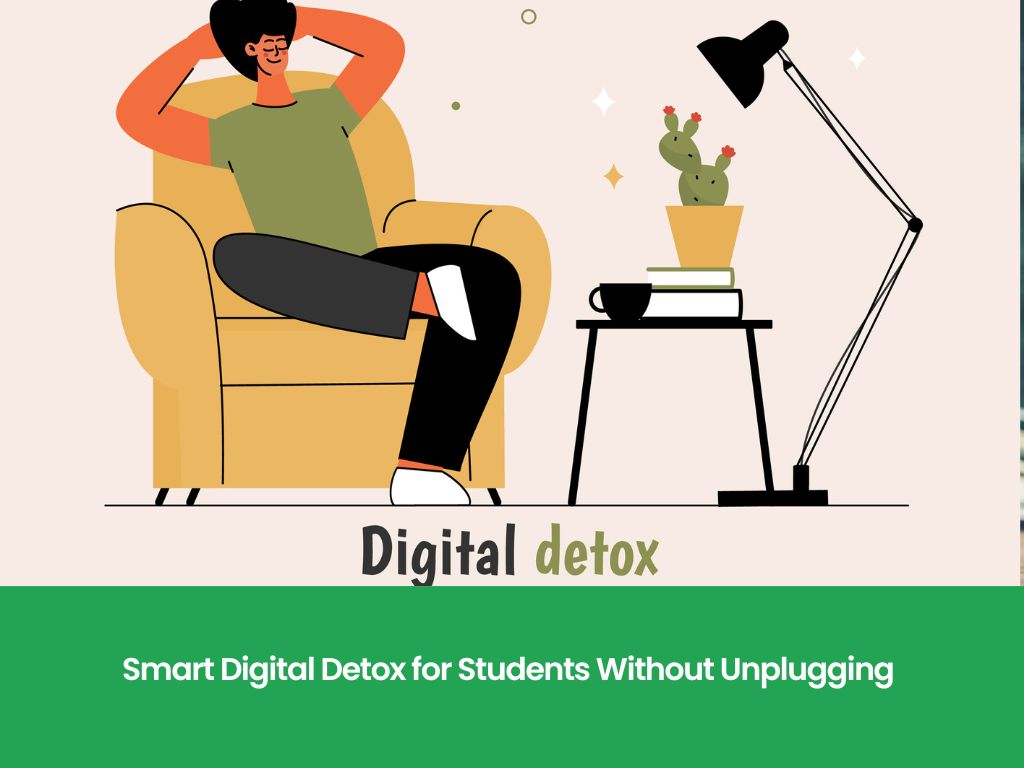Introduction
With today’s hyper-connectedness, students are spending record amounts of time on screens. From virtual classes and e-learning sites to social media and game apps, the digital universe is now deeply embedded in their daily routines. While technology has numerous benefits, excessive exposure can cause stress, anxiety, sleep problems, and lack of concentration. So how do we balance in a healthy way? In comes the concept of a digital detox — not the kind that requires total disconnection, but a smarter, more sustainable one that enables students to disconnect without going completely offline.
Let’s be honest — asking students to go cold turkey on screens isn’t realistic. Assignments, research, online submissions, and even everyday communication increasingly rely on digital platforms. The trick is to balance productive versus unproductive screen time. When technology is used to learn, create, or collaborate, that’s useful. But when it becomes a source of distraction or addiction, it needs to be addressed.
Why “All or Nothing” Doesn’t Work
The old-fashioned notion of a digital detox is to pull the plug on all electronics. Although that may be effective in the short term for adults on holiday, it’s unrealistic for students who must use their devices for school. Actually, compelling them to go cold turkey could cause them more anxiety or leave them feeling out of touch with their studies or social networks. What they require is a smart, structured, and student-friendly solution — one that teaches rather than encourages avoidance.
The Idea of Smart Digital Detox
A smart digital detox invites students to analyze their digital routine, recognize time-wasting activities, and have a healthy habit that involves screen time but in moderation. The intention is not to cut out the use of tech but to make it mindful and purposeful.
Practical Methods to Detox Without Disconnecting Totally
1. Audit Screen Time
The first step is awareness. Students should use built-in tools like Digital Wellbeing (Android) or Screen Time (iOS) to see how much time they’re spending on different apps. Once they recognize where the hours go, they can make smarter choices. This process helps distinguish between academic usage and entertainment-driven scrolling.
2. Set “Tech Zones” and “Tech-Free” Zones
Not all areas of the home or classroom must be technology-driven. They are places where tech-free zones must be encouraged, like the dinner table, bedroom at bedtime, or play areas outside. Meanwhile, set aside certain times for device use, particularly for learning or significant interaction.
3. Practice Mindful Scrolling
Challenge students to think before accessing social media or YouTube. Are they launching the app because of habit or boredom? Are they getting something out of it? Schools such as Gyan Ashram School, among Best Schools in Jaipur, have incorporated digital literacy programs that teach students to think more carefully about their online actions and to watch content thoughtfully.
4. Use Technology to Limit Technology
There are a number of apps that can be used to encourage focus and minimize distraction. Applications such as Forest, Focus To-Do, or Pomofocus assist students in staying focused with timers and visual reminders. Website blockers such as StayFocused or Freedom temporarily disable distracting websites during study time.
5. Prioritize Sleep Hygiene
Overnight screen use is one of the most significant causes of sleep deprivation for students. Blue light disrupts melatonin release, impacting sleep patterns. Students can be encouraged to turn off gadgets at least an hour prior to sleeping and practice offline unwinding activities such as reading a book or journaling.
6. Adopt Offline Hobbies
Parents and schools need to encourage non-digital interests. Playing board games, gardening, art, music, or sports helps students learn outside the screen. Not only do such activities relieve the mind, but they also foster creativity and socialization.
7. Take “Digital Sabbaticals”
Rather than requiring students to turn off devices altogether, implement digital breaks throughout the day. Part of each evening or a whole Sunday afternoon can be screen-free. Spend this time interacting with family, attending community events, or taking walks outside.
Role of Schools in Promoting Balanced Digital Habits
Schools have an important role in developing tech habits. Schools can introduce screen-free periods, promote outdoor play, launch awareness campaigns, and educate children about mental well-being. Gyan Ashram School, one of Top School in Jaipur, ensures that activities like “Tech-Free Thursdays” and offline creative challenges allow students to move away from screens without staying inactive intellectually.
Benefits of a Smart Digital Detox
Students who have adopted responsible tech habits have the following advantages:
- Improved concentration: Decreased distractions enhance focus and academic achievement.
- Enhanced emotional health: Reduced screen time reduces anxiety and encourages emotional stability.
- More meaningful relationships: Off-time increases quality time with family and peers.
- Increased creativity: Boredom tends to stimulate creativity, which screens tend to shut down.
- Healthier sleep patterns: Constrained evening screen time leads to improved sleep quality.
Tips for Parents and Educators
Parents and educators need to collaborate with each other to guide students towards a healthy tech balance. Here’s how:
- Model good screen habits yourself — children learn what they see.
- Have open discussions regarding digital exhaustion and mental wellbeing.
- Reward screen-free accomplishments and provide incentives that aren’t device-related.
- Use technology as a resource, not a crutch — balance digital with the real world.
Conclusion
Technology is here to stay, and rightfully so — it enhances learning, connects people, and makes life easier. But excessive digital consumption can have long-term effects, particularly on young minds. That’s why students don’t require a digital detox in its entirety — they require a wise one. One that instills discipline, promotes self-awareness, and fosters both online and offline lives. With the proper mindset at home and in school, students can master juggling the best of both worlds.
By developing this type of digital mindfulness from an early age, schools such as Gyan Ashram School are not only creating smart students but emotionally well-balanced individuals — ready to succeed in a technology-based future without becoming consumed by it.

